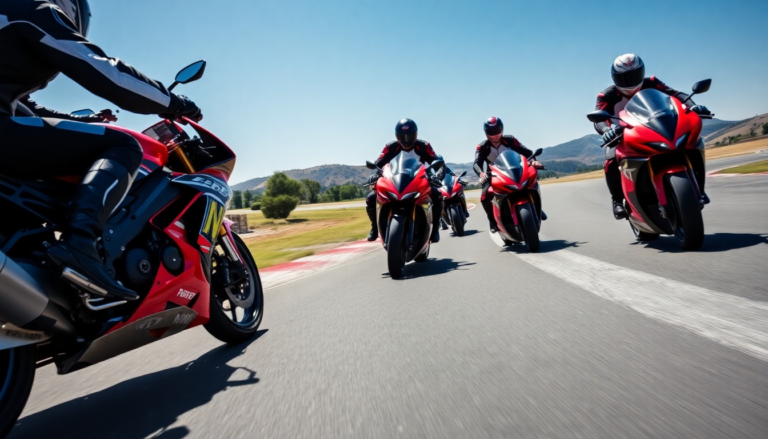Argomenti trattati
A year ago, I embarked on an adventure that transformed my approach to motorcycle riding by participating in the Level I course at the California Superbike School. My initial experience at the NCM Motorsports Park in Bowling Green, Kentucky, was both exhilarating and overwhelming. The techniques I learned were abundant, and I was concerned about retaining all that knowledge. Fortunately, over the past twelve months, I practiced diligently, and while perfection remains elusive, my confidence and skills have grown significantly.
Preparing for Level II amidst stormy skies
When I felt ready to tackle the Level II class, I signed up for the same track. As the date drew closer, the weather reports grew increasingly ominous, with severe storms and tornado warnings threatening to disrupt our plans. On the eve of the class, I reached out to California Superbike School, and they assured me to show up no matter the conditions. While I could manage rain, the thought of tornadoes looming overhead was another matter entirely. If only I could have consulted the Wicked Witch of the West for advice!
On the morning of the class, I arrived to cloudy skies but dry conditions. Students mingled as they checked in, sipping coffee while the dedicated staff of CSS scrambled to get us started before the weather could take a turn for the worse. Most of my fellow students were returning after taking Level I and II back-to-back, and they seemed cheerful about their decision. Personally, I appreciated having a year to refine my skills before jumping into the next level.
Classroom insights and eye-opening lessons
We settled into the classroom, where the familiar routine was explained: alternating between classroom instruction and on-track practice every twenty minutes. It was a relief to see my on-track coach from the previous year, Lyle, among the instructors. But first, we were introduced to Dylan Code, the founder’s son, who began by discussing Level II’s focus on vision, a continuation of what we had touched upon in Level I.
What struck me was how much there is to learn about our eyesight and its influence on riding. Having opened a fresh pair of contacts that morning felt fortuitous. The instructors utilized a mix of whiteboard drawings and engaging videos to illustrate their points. One particularly enlightening video showcased the eyes of beginner riders, flitting wildly around the track compared to the steady gaze of professional racers. The contrast was astounding.
Mastering eye discipline proved more challenging than I anticipated. Just like the classic phrase, “Don’t think about an elephant,” I found that instructing myself not to look too far ahead, backward, or at other riders was counterproductive, often leading my eyes exactly where I didn’t want them to go. Dylan emphasized that every moment spent looking elsewhere was a moment of vital visual information lost—those milliseconds can add up quickly.
Weathering the storm and refining techniques
After our first twenty-minute track session, I returned to class with a slight headache while the second group ventured onto the track. Unfortunately, their session was cut short by rain and lightning. As we waited for the storm to pass, we took turns on a stationary bike, where a coach provided feedback on our body positioning. Once everyone had their turn, the weather forecasts hinted at a break in the storm.
We seized the opportunity to have an early lunch, knowing we’d need to wrap things up quickly to avoid more bad weather later. CSS was well-prepared, keeping the paddock stocked with snacks and drinks to keep us energized throughout the day.
As soon as the rain subsided, it was time to don our gear and hit the track once again. My on-track coach for the day, Johnny, advised me to switch my bike to Rain mode and ride cautiously, paying attention to potential water hazards. Taking his advice, I completed the session without a hitch. Riding at a slower pace ultimately allowed me more time to think through the exercises and hone my technique.
Progressing through levels and trying new bikes
As the track dried, we were treated to a well-structured series of lessons that built on one another, ensuring we absorbed each technique without feeling overwhelmed. Johnny’s coaching was invaluable. His insights on cornering helped me tackle the sections where I struggled, and his encouragement in areas where I excelled boosted my confidence tremendously. After each session, we would devise a focused plan for our next outing.
Due to the weather interruptions, I didn’t have the chance to utilize the Lean Machine, but I did get to experience something new. In Level I, I had rented a BMW G 310 R, which I enjoyed, but for Level II, I opted for the BMW S 1000 R. While I didn’t need the extra power, every time I swung my leg over that bike, a grin spread across my face. Another student who rode the S 1000 R shared my enthusiasm, declaring his intent to acquire one for himself as soon as he could. The standard rental bike at the school is the S 1000 RR, with other models available upon request.
Wrapping up an unforgettable experience
Despite the smaller class size, we wrapped up early, allowing us to escape the impending storms. The goodbyes were brief as we hurried to pack up and head home. As I drove for two hours, tornado sirens blared in the background. Even though I wasn’t on a bike, I practiced focusing my gaze on the road, resisting the urge to check my phone for weather alerts.
After two courses with California Superbike School, I can’t recommend it highly enough. Whether or not you plan to attend track days or ride sportbikes, the skills and techniques gained here have significantly enhanced my street riding and bolstered my confidence. Classes are available from March to November at various tracks across the U.S., so if you’re interested, make sure to register early—spots fill up fast!

